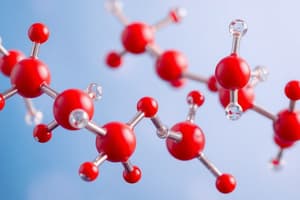Podcast
Questions and Answers
What are macromolecules composed of in a polymer?
What are macromolecules composed of in a polymer?
- Monomers (correct)
- Atoms
- Proteins
- Lipids
Which type of subunits do lipids contain?
Which type of subunits do lipids contain?
- Amino acids and nucleotides
- Nucleotides and sugars
- Fatty acids and glycerol (correct)
- Sugars and amino acids
What is the carbon-hydrogen-oxygen ratio of most carbohydrates?
What is the carbon-hydrogen-oxygen ratio of most carbohydrates?
- 2:1:2
- 1:2:1 (correct)
- 1:3:2
- 2:2:1
Which type of carbohydrates are referred to as complex carbohydrates?
Which type of carbohydrates are referred to as complex carbohydrates?
Which enzyme breaks down lactose?
Which enzyme breaks down lactose?
Which molecule serves as long term energy storage for both animals and plants?
Which molecule serves as long term energy storage for both animals and plants?
What differentiates saturated fatty acids from unsaturated fatty acids?
What differentiates saturated fatty acids from unsaturated fatty acids?
What is the main function of phospholipids in biological systems?
What is the main function of phospholipids in biological systems?
What is the common characteristic of lipids according to the text?
What is the common characteristic of lipids according to the text?
What structural feature prevents cellulose from being digested by humans?
What structural feature prevents cellulose from being digested by humans?
Flashcards are hidden until you start studying
Study Notes
Polymers and Macromolecules
- A polymer is a large molecule composed of many smaller units called monomers.
- Carbohydrates, lipids, proteins, and nucleic acids are examples of macromolecules.
- There are four main types of monomers: sugars, amino acids, fatty acids, and nucleotides.
Carbohydrates
- Most carbohydrates have a carbon-hydrogen-oxygen ratio of 1:2:1 (CH2O).
- Monosaccharides are simple sugars with a carbon backbone of 3-7 carbons.
- Examples of monosaccharides include glucose (hexose sugar), fructose (found in fruits), and galactose (found in milk).
- Disaccharides are formed by combining two monosaccharides, such as maltose (glucose + glucose), sucrose (glucose + fructose), and lactose (glucose + galactose).
Complex Carbohydrates
- Polysaccharides are long polymers composed of many subunits, including starch, glycogen, and cellulose.
- Starch and glycogen are used for energy storage in plants and animals, respectively.
- Cellulose is a structural polysaccharide found in plant cell walls and is indigestible by humans.
Lipids
- Lipids are hydrophobic molecules that are insoluble in water.
- Triglycerides (fats and oils) are used for long-term energy storage in animals and plants.
- Phospholipids form membranes and separate environments, while steroids function as sex hormones.
- Fats are solid at room temperature, while oils are liquid.
Fats and Oils
- Triglycerides are composed of a glycerol unit and three fatty acid molecules.
- Fats are emulsified by bile in the intestines, and the liver produces bile.
- Fatty acids are hydrocarbon chains with an acidic group (-COOH) and contain 16 or 18 carbon atoms.
Phospholipids and Steroids
- Phospholipids have a phosphate group and are the primary components of cellular membranes.
- Steroids have a backbone of four fused carbon rings, and cholesterol is a precursor for other steroids like bile salts, estrogen, and testosterone.
Studying That Suits You
Use AI to generate personalized quizzes and flashcards to suit your learning preferences.



